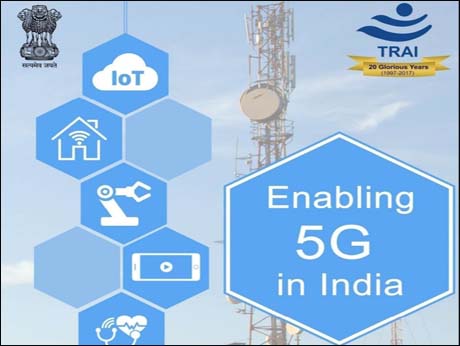
New Delhi March 1 2019: The Telecom Regulatory Authority of India (TRAI) has released a White Paper on 'Enabling 5G in India'.
The White Paper highlights the specifications of the 5G technology, discusses the potential use cases and architecture of 5G network, deliberates those areas that will require investment for 5G deployment, covers the spectrum requirements for 5G networks, and tries to identify regulatory challenges that need to be addressed for the deployment of 5G in India.
Globally, full scale deployment of 5G networks is expected to start by late 2019 or early 2020 for which pilots have already commenced. India's 5G High Level Forum envisages 5G to be deployed in India by 2020 along with the rest of the world.
In its introduction, the White Paper says:
The commercial deployment of 5G was earlier expected in 2020. However, the completion of the first 5G New Radio (5G NR) standard for a Non- Standalone (NSA) solution in December 2017 and for Stand Alone (SA) standard in June 2018 has set the stage for the global mobile industry to start full-scale development of 5G NR for large-scale trials and commercial deployments as early as in 2019.
In the past it is observed that technological deployment in India has not been concurrent along with that of the most developed countries in the world. However, India is planning meticulously to launch 5G abreast with rest of the world.
A 5G High Level Forum (5G HLF) was set up by the Government in September 2017 to articulate the vision for 5G in India and to recommend policy initiatives & action plans to realize this vision. The 5G HLF has released a report2 in August 2018 titled “Making India 5G ready” suggesting measures in the area of Spectrum Policy, Regulatory Policy, Education and Awareness Promotion Program, Application & Use Case Labs, Development of Application Layer Standards, Major Trials and Technology Demonstration and Participation in International Standards
The Government has launched a programe titled ‘Building an End-to-End 5G Test Bed’4 to advance innovation and research in 5G. This three-year program began in March 2018, with a budget authorization of Rs 2,240 million. The program has been awarded to Indian Institutes of Technology (IIT) Madras, IIT Hyderabad, IIT Delhi, IIT Kanpur, Centre of Excellence in Wireless Technology (CEWIT), Society for Applied Microwave Electronics Engineering & Research (SAMEER) and Indian Institute of Science (IISc) Bangalore. The program envisages close collaboration between the universities and small technology companies. The goal of the program is to build proof-of-concept 5G prototypes that are broadly compliant with the 3GPP standards. Several academic R&D programs around 5G themes have also been funded by Department of Science and Technology (DST) and Ministry of Electronics and Information Technology (MEITY).
On the standards front, Department of Telecommunications (DoT) and Telecommunications Standards Development Society, India (TSDSI) in collaboration with the IITs have been successful in getting the Low Mobility Large Cell (LMLC) use case accepted in the International Mobile Telecommunications-2020 (IMT-2020) requirements. LMLC reflects the needs of rural India and other similarly placed countries. TSDSI is currently working with 3GPP to include specifications in Release 15 standard that support the LMLC use case.|
Ericsson has installed the first public access 5G test bed at IIT Delhi in July 2018 for developing applications in the broadband and low latency areas and has provided access to the industry and institutions to work on India specific usage scenarios and applications.
Mobile data usage per month in India has increased from 39 Petabytes in June-2016 to 4178 Petabytes in September-2018 thereby showing an increase of many folds. With the exponential growth in data usage, India has become one of the countries with highest mobile data usage. |
According to GSMA intelligence (GSMAi), 208 million new subscribers will get connected in India by 2025, accounting for a quarter of global and half of regional [Asia-Pacific (APAC)] new subscribers over 2017-2025 period. By this time, smartphone connections in the country will account for three quarters of total connections.|
5G will help to cater the growing demand for high speed internet. Moreover, it will unleash new business opportunities and bring substantial socioeconomic benefits through increase in productivity, improvements in service delivery, optimum use of scarce resources as well as creation of new jobs.
According to 5G HLF, 5G is expected to be launched in India by 2020 and is predicted to create a cumulative economic impact of USD 1 trillion in India by 2035. As per Ericsson, 5G enabled digitalization revenue potential in India will be above USD 27 billion by 2026. GSMAi projects that after initially launching in 2020, 5G connections in India will grow to almost 70 million by 2025, equivalent to around 5% of total connections (excluding cellular IoT)
Find the full White Paper "Enabling 5 G in India" here